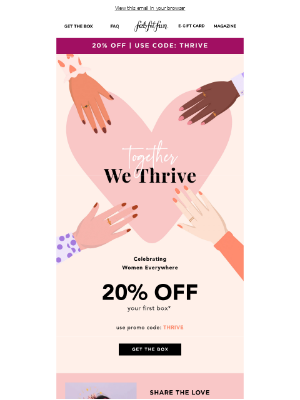International Women’s Day Email Strategy
International Women’s Day gives brands the opportunity to honor and recognize their women customers and employees.
Explore all 200 International Women’s Day emails
Sign-up for MailCharts to start planning campaign for International Women’s Day with our curated examples.
Try for freePro tip: Scroll down for hand-picked emails.
International Women’s Day on March 8 celebrates women’s history and achievements and highlights the challenges that remain for gender equity, diversity and inclusion. As more consumers expect brands to take stands on issues that reflect their values – and to put some money into the effort – more companies are tying campaigns to the day as a way to recognize their women customers and show support.
In a recent study done on millennials, 83% of respondents said they think it’s important a company’s values align with their own. We think that because of this trend, we’ll continue to see email examples like the ones highlighted below in future Women’s Day emails as well as throughout the year.
International Women's Day email campaigns
International Women's Day messaging tips

Planning upcoming campaigns and promotions?
MailCharts’ unparalleled depth of e-commerce data allows you to find examples for creative briefs, promotional calendars and more.
International Women's Day email campaigns
Multicultural recognition
Eight tough women and one Tough Mother.
Sent by Columbia Sportswear
Some brands slap a “Happy International Women’s Day” banner and a discount on a standard email campaign and call it a day. Columbia shows how to create an email with a strong multicultural message for IWD that also includes curated merchandise assortments to shop.
Sign up free for 200 curated examples
Supporting the makers
Happy International Women's Day
Sent by Pottery Barn
If your brand has developed a partnership with a program that benefits girls or women, International Women’s Day gives you an authentic way to promote it. Pottery Barn’s email campaign highlights how it supports women artists and crafters who make projects the company sells in its stores.
Sign up free for 200 curated examples
Multiple messages
Here's to women 🏆
Sent by FabFitFun
International Women’s Day pairs naturally with other inclusive values like promoting diversity and inclusion in images. The promotion is more obvious than in many other IWD emails, but it doesn’t feel exploitative because all the elements reinforce the International Women’s Day theme, right down to the “Women’s Empowerment Filter” and the “Thrive” promo code.
Sign up free for 200 curated examples
Putting customers first
💪 It's International Women's Day
Sent by Zenni Optical
Want to make your customers feel valued? Make them the star of your campaign! Bonus: Let them tell their stories in their own words. Zenni combines inspiration and promotion by keeping the women’s stories in focus. But the prominent “Shop Now ” call-to-action buttons encourage readers to browse the eyewear, and the message design moves the eye down to the company values statement.
Sign up free for 200 curated examples
Company commitment
It’s International Women’s Day
Sent by ADAY
Putting employees front and center in an International Women’s Day email campaign and letting them speak their own words is another way to send a values-focused message. ADAY breaks away from its clothing line to promote women artists, a nonprofit and company social hashtags that align with company values.
Sign up free for 200 curated examples

Planning upcoming campaigns and promotions?
MailCharts’ unparalleled depth of e-commerce data allows you to find examples for creative briefs, promotional calendars and more.
International Women's Day messaging tips
Be authentic in your message and content
Cause-related campaigns can give your customers more reasons to engage with your brand, but they require extra care in how you build your message.
If your brand doesn’t have a natural tie-in to women, don’t try to focus on a connection. But if your company does have a history of supporting women’s causes and advancement, tell your story simply and honestly.
Don't mix your messages
If you decide to do a meaningful International Women’s Day campaign, make that the focus of your campaign to drive the greatest impact. You can combine commerce and cause marketing if there’s a logical tie-in, as you can see in the email examples above. But you won’t make much of an impression if you just add an IWD subject line or banner to a standard promotional email.
Make your customers (or employees) the heroes in your message
Sure, you have a great story. But remember one of the commandments of good copywriting: “Show, don’t tell.” Share the story through the eyes of the women who benefit from your message, or the woman who lives the story. That’s who your customers really care about.

Planning upcoming campaigns and promotions?
MailCharts’ unparalleled depth of e-commerce data allows you to find examples for creative briefs, promotional calendars and more.
